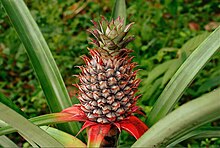**Botanical Information**
– Pineapple is a herbaceous perennial plant.
– It grows to 1.0 to 1.5m tall on average.
– The plant produces up to 200 flowers that join together to create a multiple fruit.
– Side shoots called suckers are produced for propagation.
– Pineapples have 30 or more long, sharp-spined leaves.
– Pineapple comprises five botanical varieties: bracteatus, comosus, erectifolius, microstachys, and parguazensis.
– The genomes of three varieties have been sequenced.
– Distribution ranges from Brazil to various islands in the Pacific.
**Historical Background**
– The first English reference to the pineapple fruit was in 1568.
– Pineapple cultivation dates back to precolonial times in South America.
– Pineapples were encountered by Columbus in Guadeloupe in 1493.
– The term ‘pineapple’ originated from the Tupi word ‘nanas.’
– Pineapple cultivation dates back to 1200–800 BC in Peru.
– The Portuguese introduced pineapples to India by 1550.
– Mass commercialization of pineapples began in the 19th century.
**Nutritional Information**
– Raw pineapple is 86% water.
– Rich source of manganese and vitamin C.
– Negligible fat content.
– Provides 209 kJ of energy per 100g.
– Contains various vitamins and minerals.
– 50 kcal energy per 100g.
– High in carbohydrates and sugars.
– Good source of dietary fiber.
– Rich in vitamin C.
– Contains essential minerals like potassium and manganese.
**Cultivation and Production**
– In 2022, global pineapple production reached 29 million tonnes.
– Indonesia, the Philippines, and Costa Rica were the top producers.
– Flowering can be induced artificially in commercial farming.
– Early harvesting of the main fruit can encourage the growth of a second crop.
– Pineapple tops can be planted to grow new plants.
– Slips and suckers are commonly planted commercially.
**Uses and Industry**
– Pineapple is used worldwide in various cuisines, sold fresh, and used in dishes like Hawaiian pizza.
– Pineapple juice is popular in cocktails like piña colada.
– Pineapple vinegar is utilized in Honduran and Filipino cuisine.
– Pineapple is a significant economic crop, with a notable trade in pineapple juice.
– Pineapples are canned in sugar syrup post-harvest.
– Pineapples play a role in economic activities and global trade.
The pineapple (Ananas comosus) is a tropical plant with an edible fruit; it is the most economically significant plant in the family Bromeliaceae.
| Pineapple | |
|---|---|

| |
| A pineapple on its parent plant | |
| Scientific classification | |
| Kingdom: | Plantae |
| Clade: | Tracheophytes |
| Clade: | Angiosperms |
| Clade: | Monocots |
| Clade: | Commelinids |
| Order: | Poales |
| Family: | Bromeliaceae |
| Genus: | Ananas |
| Species: | A. comosus
|
| Binomial name | |
| Ananas comosus | |
| Synonyms | |
|
List
| |
The pineapple is indigenous to South America, where it has been cultivated for many centuries. The introduction of the pineapple plant to Europe in the 17th century made it a significant cultural icon of luxury. Since the 1820s, pineapple has been commercially grown in greenhouses and many tropical plantations.
Pineapples grow as a small shrub; the individual flowers of the unpollinated plant fuse to form a multiple fruit. The plant normally propagates from the offset produced at the top of the fruit or from a side shoot, and typically matures within a year.
